Social media is an important marketing component for many ecommerce merchants. As such, effectively managing engagement on sites like Facebook, Twitter, LinkedIn and YouTube is critical.
The following is a list of four tools that I use for my own business — and my clients’ businesses. These four tools help conserve the time needed for engagement and, yet, cover social network monitoring, content production, syndication and ongoing community management.
While no one tool does everything, I opt for those that are the most comprehensive — and affordable for a small business budget. Having tested a number of such tools over the years, these are the ones I use repeatedly.
SocialMention
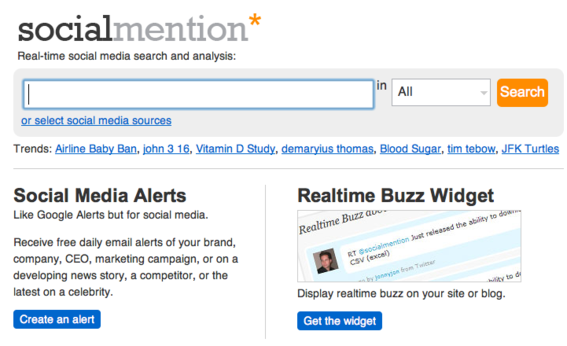
SocialMention is a free social media monitoring tool.
A necessary element of effective social media engagement is “listening” – monitoring the conversations about your brand, products, services or industry. There are a number of tools that do this, most require a paid monthly subscription.
However, one free tool that does a good job of covering the entirety of the social media universe is SocialMention. Based on the use of keywords, it pulls data from social networks, microblogs (such as Twitter), forums, blogs, multimedia (video and images) and social-bookmarking sites.
For example, a search on the term “ecommerce” pulled the following returns.
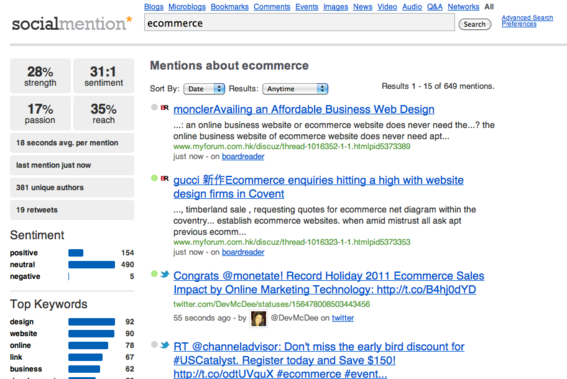
SocialMention returns for “ecommerce.”
In addition to monitoring blog comments, tweets, forum posts and social network status updates, SocialMention provides analytics to help business owners gauge the influence of their brands and effectiveness of their engagement efforts. It measures the following four attributes.
- Strength. A percentage showing how likely a brand is to be mentioned in social media. It’s a ratio based on the number of mentions within a 24-hour period divided by the total possible mentions, as determined by SocialMention’s algorithm.
- Sentiment. The ratio of mentions that are largely positive compared to those that are largely negative.
- Passion. A measure of the likelihood that those who mention a brand will do so repeatedly.
- Reach. The measure of how far-reaching the brand’s influence is, showing the number of those likely to see it.
In terms of accessing data, SocialMention provides several options. Users can:
- Visit SocialMention.com to input keywords and see data returned in almost real-time;
- Subscribe to an RSS feed so that data is sent to a feed reader, such as Google Reader;
- Subscribe to email alerts;
- Download results in CSV or Excel file formats for ongoing record-keeping.
Lastly, SocialMention shows (a) top keywords used with brand mentions, (b) top users, (c) top hashtags, and (d) top sources, such as Twitter, YouTube, and Facebook.
HootSuite
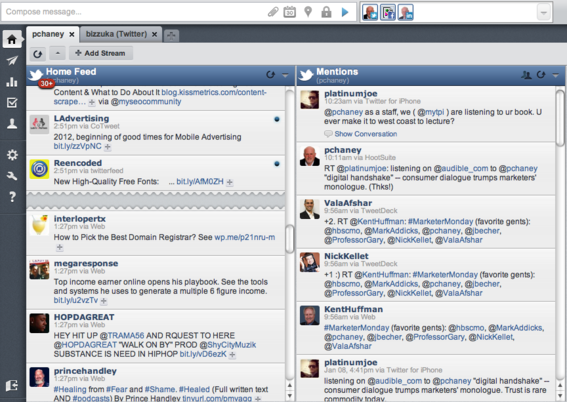
HootSuite’s simple user interface makes posting easy.
I use HootSuite because its simple interface makes posting to Twitter and other social networks easy. I can set up multiple social network accounts and customize the dashboard to suit my needs in terms of the data displayed, such as tweets and Facebook status updates. Using the Premium version — pricing starts at $5.99 per month — I can assign multiple administrators to manage the accounts, as well.
Further, HootSuite allows me to schedule updates, attach images or other document file types (PDF, .doc, CSV) add location information, and choose privacy settings for social networks like Facebook and LinkedIn to control who sees the posts.
I use HootSuite mostly for real-time posting of content to Twitter, Facebook and LinkedIn, as well as for interacting with my community — responding to Twitter @mentions and direct messages — and less as a tool for scheduling posts over time.
Note that TweetDeck is a similar, popular tool. It performs roughly the same set of functions as HootSuite, but does not allow for multiple administrators.
Roost
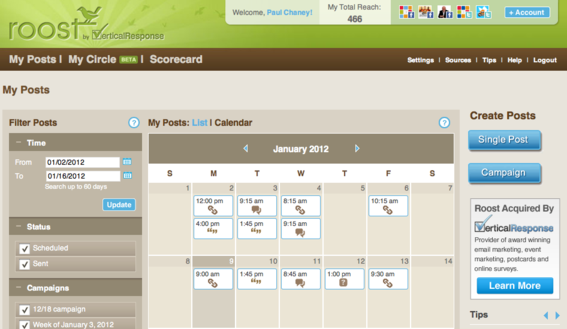
Roost is designed to be used as a publishing tool.
Roost is a publishing tool. Unlike SocialMention and HootSuite, it does not provide users with the ability to monitor conversations from others.
The app enables me to set up multiple social network accounts and choose to which of those accounts I wish to publish at any given time. I can create either single posts or set up a series, called “Campaigns.”
For example, if I have a special promotion such as a limited-time offer, I can create a Campaign labeled “Special Offer,” then create a series of posts tied to it.
Roost’s calendar view option enables me to see at a glance how many posts I have scheduled for a given time — day, week or month — and to which accounts content is scheduled.
Lastly, as an alternative to creating original content, Roost provides a library of suggested content pulled from blogs and other websites based on a variety of categories, such as humor, news, travel, and food. I can also create my own list of categories and subscribe to RSS feeds from related sites.
Postling
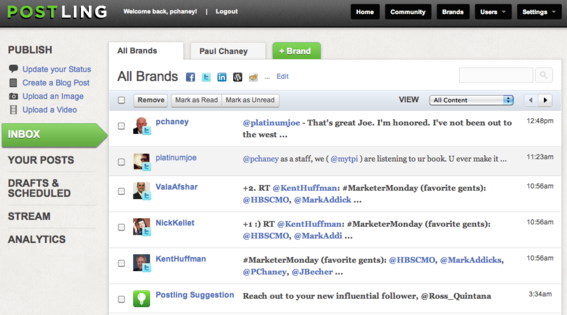
Postling is the most comprehensive of all the tools on the list.
In my search for the one comprehensive tool, I have found that Postling fits most of my needs. I can use it as a publishing tool similar to Roost, but also have the ability to see interactions from Facebook Fans and Twitter followers. By inputting keywords, I can use it as a listening tool like SocialMention.
Because Postling facilitates integration with platforms like WordPress, TypePad, and Tumblr, I can even use it for posting to my blog. Moreover, I can create multiple brand accounts, choose from many social networks, and set up multiple administrators.
Postling is not free. But it is affordable. Pricing starts at $1.00 for the first 30 days, then $3.00 per month thereafter for each social network used. For most small businesses, that would mean a monthly outlay of no more than $15 to $20.
Conclusion
Based on my longtime use of social-management tools, SocialMention, HootSuite, Roost, and Postling work best for me. There are many other tools, of course. I’ve previously described some of them in “15 Services to Manage Your Social Media Activity” and “5 New Social Media Management Platforms,” two previous articles.





